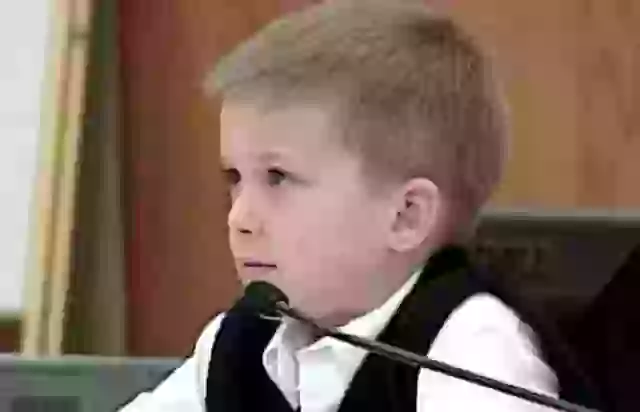In a quiet Florida town in 2007, a heartbreaking story unfolded that would capture national attention and raise difficult questions about justice, childhood trauma, and the power of a child’s voice. Seven-year-old Adrianna Hutto was found unconscious in her family’s backyard pool in Esto. Her mother, Amanda Lewis, told first responders it was a tragic accident—Adrianna must have slipped in when she wasn’t looking. But it was Adrianna’s little brother, AJ Hutto, just six years old, who spoke up and turned the case upside down.
According to AJ Hutto, their mother didn’t just find Adrianna in the pool—she put her there. His words shocked the investigators, the courtroom, and the world. A year later, he would testify against his own mother, a decision that forever changed his life. Nearly two decades later, AJ is finally sharing his truth, reflecting on the trauma, and speaking publicly about what he saw.
A Tragic Death and a Stunning Accusation
August 8, 2007, began like any summer day. But it ended in horror. Amanda Lewis called 911, saying she had found Adrianna floating in the family’s above-ground pool. Paramedics arrived quickly and transported the girl to Bay Medical Center, but doctors could not revive her. Doctors pronounced her dead shortly after arrival.

At first, it looked like a tragic accident. Amanda claimed she had stepped away for just a few minutes. But when detectives spoke with AJ Hutto, he calmly told a different story. He said his mom got angry and threw Adrianna into the water. “She done some stuff she wasn’t supposed to,” AJ explained during the interview.
He said his mother dunked his sister repeatedly and that she eventually stopped moving. AJ Hutto’s version of events was graphic and specific. He even drew pictures showing what happened, labeling the figures as “Mom” and “Sister.” The police believed him—and Amanda Lewis was arrested within days.
A Young Witness Faces the Courtroom
When Amanda’s trial began in 2008, prosecutors relied heavily on AJ’s testimony. He was now seven and still firm in what he remembered. Sitting on the witness stand with a stuffed animal in his arms, AJ Hutto spoke softly but clearly. He confirmed that he saw his mother hold Adrianna under the water.
One of his drawings became key evidence. In it, he labeled the stick figure holding another figure under water as “Mom,” and told the court, “She’s killing my sister.” His words were emotional, powerful, and deeply unsettling.

The defense tried to discredit AJ’s memory. They suggested that the questioning might have confused or influenced him. But expert witnesses said his statements were spontaneous and consistent. They believed AJ Hutto understood what he had seen—and that he was telling the truth.
In the end, the jury agreed. They found Amanda Lewis guilty of first-degree murder and aggravated child abuse. The judge sentenced her to life in prison without parole, plus an additional 30 years.
A Voice Reclaimed After Seventeen Years
After the trial, AJ Hutto was adopted into a new family. He left behind the trauma of his early childhood and began life again. He describes the change as “a 360 difference.” For the first time, he lived in a home that felt safe.
Now 24 years old, AJ is sharing his story publicly. He opened up about the years of silence and why he’s ready to speak. “I wasn’t coached. I said what I saw,” he stated. His memories, though painful, remain vivid.
According to AJ Hutto, life with Amanda wasn’t easy. He remembers being hit for small things. He believes Adrianna suffered in similar ways. While some people still question the case, AJ remains firm in his account.
He hasn’t spoken to his mother since the trial. He says reconnecting would only reopen old wounds. “It doesn’t go away,” AJ says, “but I’ve learned to live with it.”
Lingering Doubts and a Divided Public
Amanda Lewis continues to claim she’s innocent. In 2016, she appeared on Killer Women with Piers Morgan and described Adrianna’s death as a tragic mistake. Amanda claimed that others may have influenced AJ Hutto or that he misinterpreted what he saw.
Her supporters argue that convicting someone based on a child’s testimony is dangerous. They say kids can be impressionable and confused. But those who followed the trial point to AJ’s consistent story and the expert assessments backing him up.
The debate hasn’t faded. True crime communities still analyze the case. Legal experts revisit it in discussions about child witnesses. Was justice truly served, or did emotion overpower logic in the courtroom?
Whatever side people take, one fact remains: AJ Hutto told a story that has never changed—and never lost its impact.
The Power and Pain of a Child’s Truth
The story of Adrianna Hutto’s death is painful, but it also shows how one child’s voice can change everything. At just seven years old, AJ Hutto stood before a jury and told them what he saw. That moment not only shaped a courtroom verdict—it changed his entire life.
Years later, AJ is no longer the quiet boy in court. He’s a young man trying to heal, grow, and help others understand what it means to survive trauma. He doesn’t seek sympathy—only truth.
“I did what I had to do,” AJ says. “Even if it was hard.” His voice still echoes. And now, it’s stronger than ever.
Read More: Justin Bieber Speaks Out on ‘All of the Hurt,’ Sparking Increased Concern Among Fans

